|
The study approach is based on interaction between the Technical Process and the Public Participation Process.
Public Participation Process
The necessary public and stakeholder participation is achieved through the SSC meetings, liaison with its members and a regular press release. For more information on the objectives of the SSC, see the Steering Committee tab.
Technical Process
The technical process is based on the following interventions developed by the Reconciliation Strategy:
Periodical assessment of water requirements and availability (water balance update); Implementation of infrastructure projects; Undertake feasibility studies; Implementation of Water Conservation and Water Demand Management measures; Establish and maintain a System Operation Management Forum to monitor the short term behaviour of the system and manage water restrictions in the area in the event of a drought; and Update of the Reconciliation Strategy interventions.
Below is detailed information on various tasks currently being undertaken to meet the obligations of the Reconciliation Strategy.
1. UPDATING WATER REQUIREMENTS AND AVAILABILITY PROJECTIONS
The water balances depicting the water reconciliation situation in the Mdloti-Mvoti, South Coast and Mgeni WSS were updated with the latest implementation schedule of the interventions as follows:
1.1 Mdloti-Mvoti WSS
Due to the inter-connectedness of the Mdloti and Mvoti systems on the North Coast, the water balances of these systems have been integrated into a single water balance. For reconciliation planning purposes, two intervention scenarios have been identified as long term options for the North Coast. The first scenario involves the construction of Isithundu Dam (Figure 2), the second includes the recently identified indirect re-use of water via Hazelmere Dam from return flows generated in the oThongati and/or Mvoti catchments (Figure 3). This potential intervention has been formulated as part of Ethekwini’s Total Outflow Strategy that is running in parallel to the Classification process.
The water balances in Figure 2 and Figure 3 clearly show – and this is currently being experienced – that the North Coast is in a short-term deficit situation (shown in red). For both scenarios, the rapid growth in water requirements that is anticipated on the North Coast will require the following actions to maintain a sustained positive water balance:
LTBWSS1 is commissioned in 2016 (shown in a darker blue). The raising of Hazelmere Dam is completed by 2018 (shown in orange).
-
LTBWSS2 be commissioned by 2021 (shown in light blue).
Thereafter, the two alternatives are:
Isithundu Dam be implemented and would need to be commissioned by 2026 (shown in turquoise), Figure 2; or Indirect re-use of water is implemented to not only address effluent discharge constraints in the estuaries of the rivers, but also make additional raw water available at Hazelmere Dam (Figure 3). Based on the estimated growth in available return flows, the Proposed Isithundu Dam on the Mvoti River could be delayed beyond the planning horizon of 30 years.
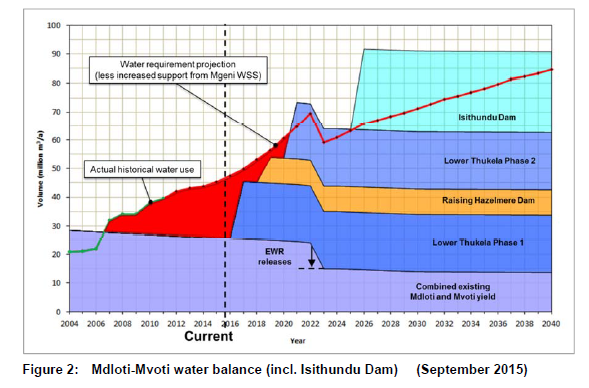
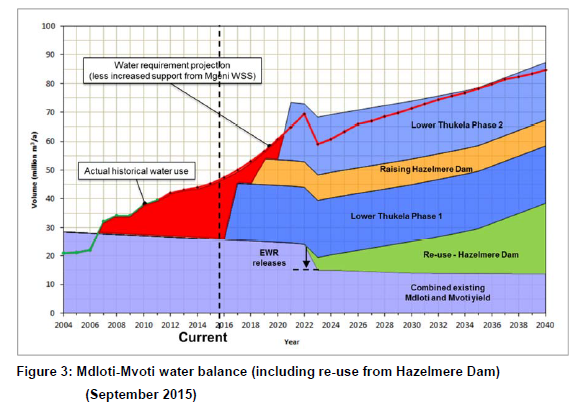
Further points to note on the two figures with regards to water requirements and water availability are:
The reduction in water requirements on the Mdloti-Mvoti WSS in 2023, represented by a decrease in the red water requirement projection line. This results from moving a portion of the water supply from Hazelmere Dam onto the Mgeni WSS when the proposed uMWP-1 is commissioned. This water will be supplied via the Northern and Western Aqueducts. Note that this implies the need for commissioning uMWP-1 and the new Northern Aqueduct by 2023 (as discussed in later in Section 1.3: Mgeni WSS). The implementation of the Reserve and associated Ecological Water Requirements (EWRs), which may require additional releases from Hazelmere Dam, is delayed until the implementation of the uMWP-1. The impact of the EWR on the yield of the system is a decrease of approximately 10 million m3/a (shown as a decrease in the purple portion at the bottom of Figure 2). The potential to off-set the EWR through the return of treated effluent is still being established and will be dealt with in more detail at the next Technical Support Group meeting.
1.2 South Coast WSS
The water balance for the South Coast WSS is shown in Figure 4. The existing water availability represents both local resources (shown in light blue) as well the support from the Mgeni WSS through the South Coast Augmentation (SCA) pipeline (shown in dark blue). Projected water requirements are shown as red lines, with and without the planned implementation of WC/WDM initiatives.
Figure 4 also shows the augmentation of the South Coast by the implementation of either the proposed Lower uMkhomazi Bulk Water Supply Scheme (Ngwadini Dam) or the desalination of seawater (both shown in green) with earliest implementation in 2019/2020. As such, a short-term shortfall is likely around 2018 to 2019. WC/WDM initiatives will be a key measure in minimising risk over this period, as well as for long term sustainable supply once the system is augmented.
The water balance in Figure 5 illustrates that once the South Coast is augmented, the support that is currently provided from the Mgeni WSS through the SCA can be reduced, making additional water available for use as a short term reprieve for the Mgeni WSS.
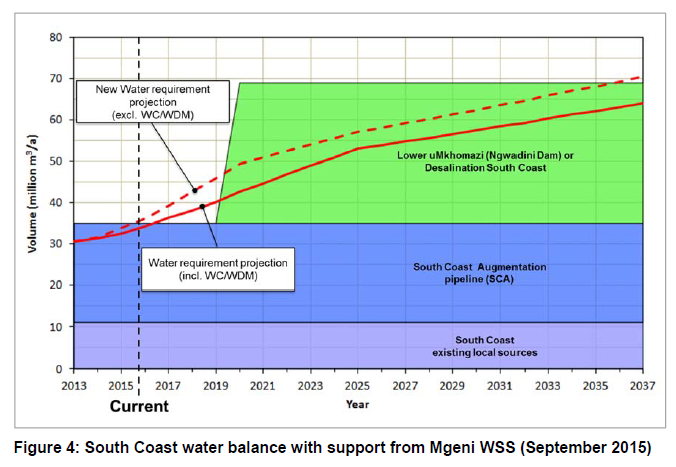
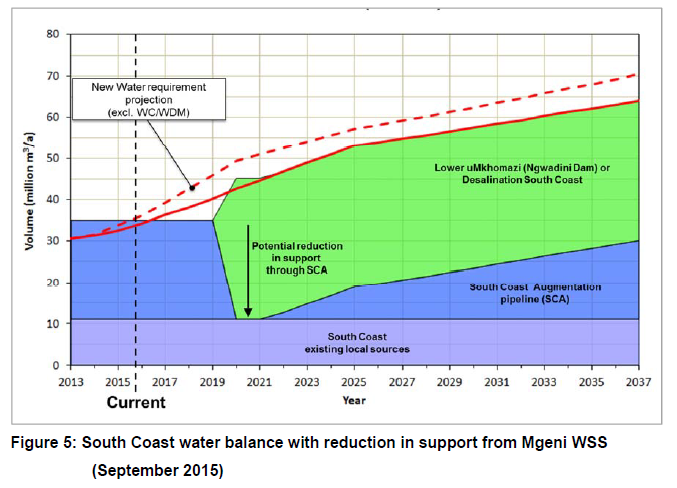
1.3 Mgeni WSS
Water requirements for the Mgeni WSS were updated to include possible system attrition due to the aging and deterioration of water supply infrastructure (see Figure 6). This can however be addressed through the appropriate implementation of the correct WC/WDM initiatives (see Figure 7), which could mitigate the increasing system losses and also achieve some water demand management savings.
The new high and low growth scenarios for the Mgeni WSS are thus those including system attrition and WC/WDM.
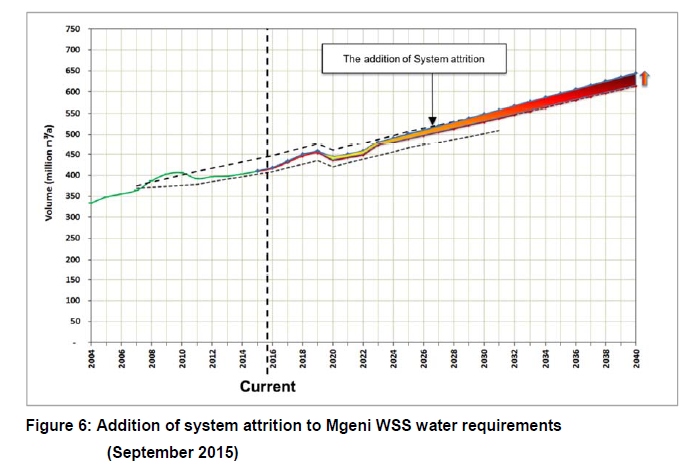
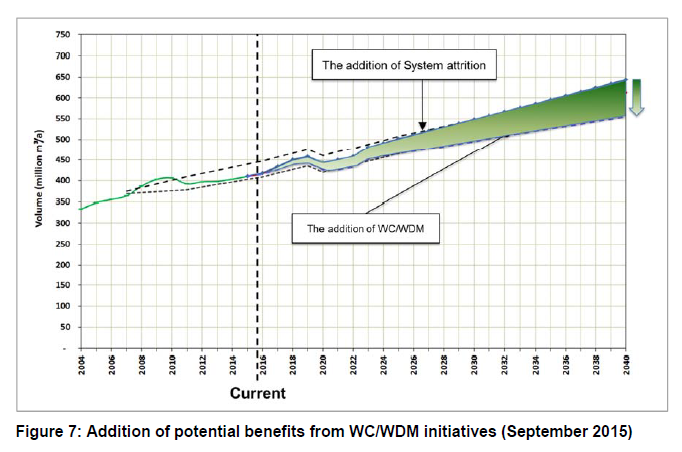
As discussed in the Status Report: February 2015 (DWS, 2015), there are several options for the augmentation of the Mgeni WSS and the reconciliation of water resources and projected water requirements. These options are summarised as follows:
Scenario 1: Implementation of re-use of treated effluent or desalination of seawater on the North Coast, followed by the uMWP-1 (shown in Figure 8). Scenario 2: Implementation of both re-use and desalination on the North Coast, followed by a delayed uMWP-1 (shown in Figure 9).
-
Scenario 3: Implementation of only uMWP-1 (shown in Figure 10).
The water requirement projection on all water balances account for the impacts of the following:
The reduction in support from the Mgeni WSS to the South Coast after the implementation of either the proposed Lower uMkhomazi Bulk Water Supply Scheme (Ngwadini Dam) or the desalination of seawater (as discussed earlier in Section 1.2), resulting in a decrease in the red line in 2020. Moving a portion of the water supply from Hazelmere Dam onto the Mgeni WSS (as discussed earlier in Section 1.1), resulting in an increase in the red line in 2023.
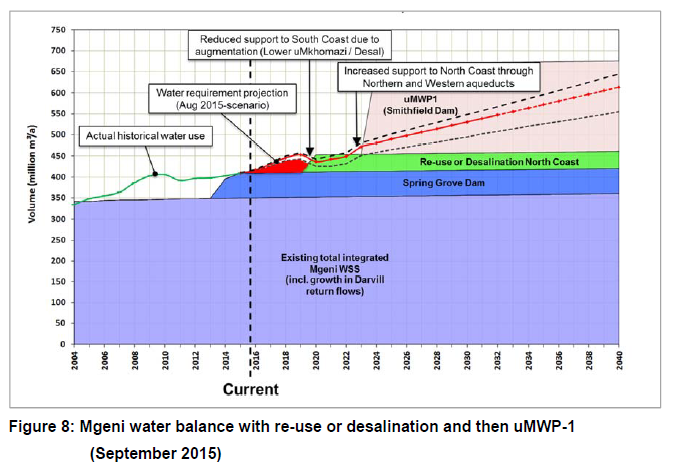
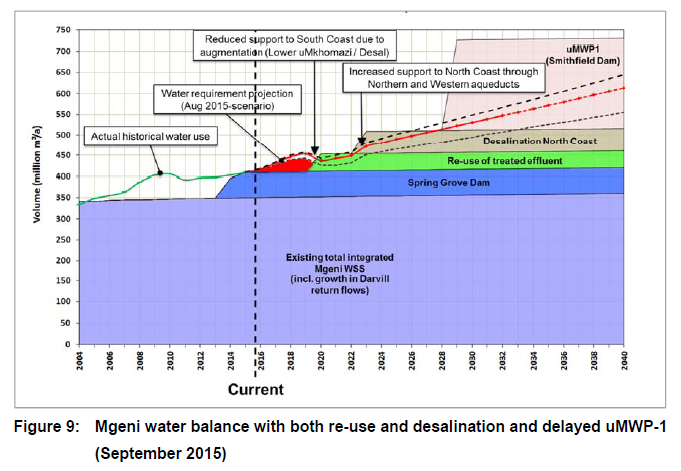
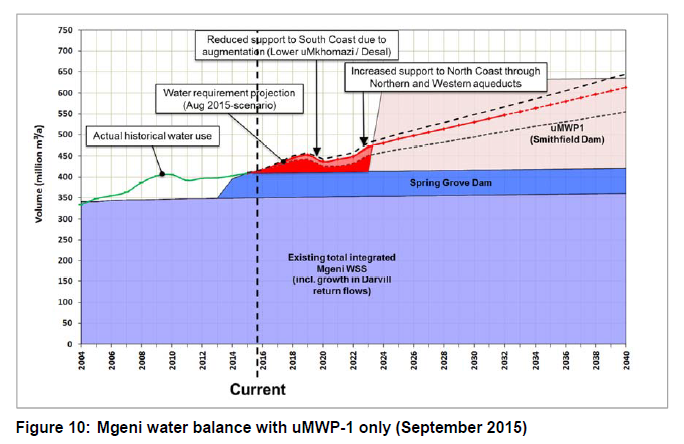
Based on the water balances for the reconciliation scenarios presented above the following is noted: Even with the recently commissioned MMTS2 (Spring Grove Dam) the Mgeni WSS remains in deficit after 2015. This deficit will increase until the Mgeni WSS can be further augmented.
-
If the re-use of treated effluent or desalination is implemented, a positive water balance can be maintained from 2020. However, the uMWP-1 (Smithfield Dam) still needs to be commissioned by 2023.
-
If both re-use and desalination are implemented, uMWP-1 can be delayed, although only for 5 years.
-
Both re-use and desalination have high energy and O&M costs, which may result in these plants being mothballed when uMWP-1, a gravity scheme, comes on line (Figure 8).
-
If uMWP-1 is implemented without re-use or desalination, a longer period of potential shortfall of about six years is projected, from 2017 to 2022.
1.3.1 Risk Assessment
The water balances discussed in Section 1.3 clearly illustrate the urgent need for augmenting the Mgeni WSS, and that uMWP-1 (Smithfield Dam) needs to be commissioned as soon as possible. Of interest is that the projected six-year shortfall period (2017 to 2022) will be similar in length and magnitude to that which was experienced in the Mgeni WSS prior to the commissioning of Spring Grove Dam (2006 to 2014). It was fortunate that during this period above average rainfall was experienced, thereby maintaining water balances at levels that were higher than those projected by earlier models. This may not be the case in the future projected shortfall period.
Within this context, an assessment was undertaken to quantify the possible implications for water users in the Mgeni WSS of the projected shortfall, based on the risks of non-supply during the shortfall period. The assessment involved a comparison of the following:
-
Projected water requirements in the system;
-
Projected water supply, based on both water volume and assurance of supply characteristics.
The approach and results of the assessment are discussed below.
a) Water user priority classification
The water user priority classification adopted for the Mgeni WSS is summarised in Table 1 and shows the distribution of the total system water use volume across four classes, namely “High”, “Medium-high”, “Medium-Low” and “Low”.
Table 1: Water user risk criteria for the Mgeni WSS

b) Projected water requirements
The total projected water requirements in the Mgeni WSS, disaggregated into the volume of water that would be required in each of the four water use priority classes is shown in Figure 11.
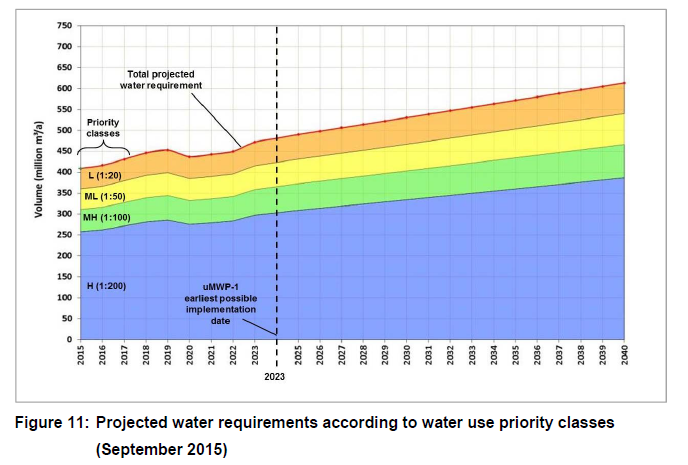
c) Projected water supply
The projected supply of water to users in the Mgeni WSS was modelled using the Water Resources Planning Model (WRPM) to analyse 2 scenarios as follows:
Scenario 1: Full water supply is targeted. Under this scenario, projected water requirements (as shown earlier in Figure 11) are fully supplied when water is available in the system. The result is presented in Figure 12 and shows how achievable assurances of supply will decrease significantly over time. Scenario 2: Water supply is curtailed. For this scenario, water supply is curtailed based on a combination of (i) the current assurance of supply characteristics of the system; and (ii) the assumption that lower priority water use will be curtailed in order to protect the higher priority water user. The result is presented in Figure 13 and shows an increasing shortfall in water supply (in red), totalling almost 20% of the total water requirement in 2023 – the earliest possible implementation date of uMWP-1.
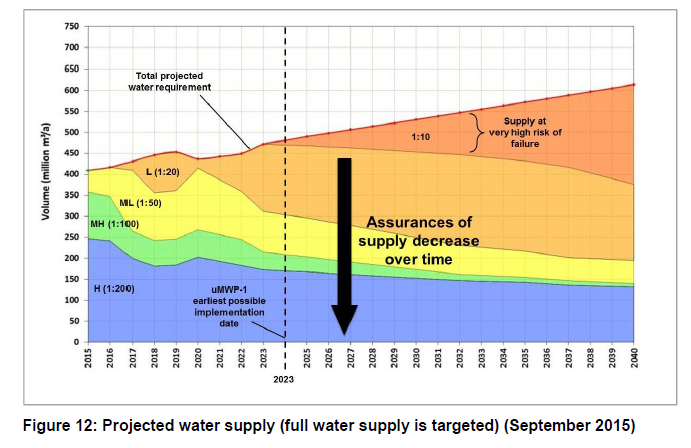
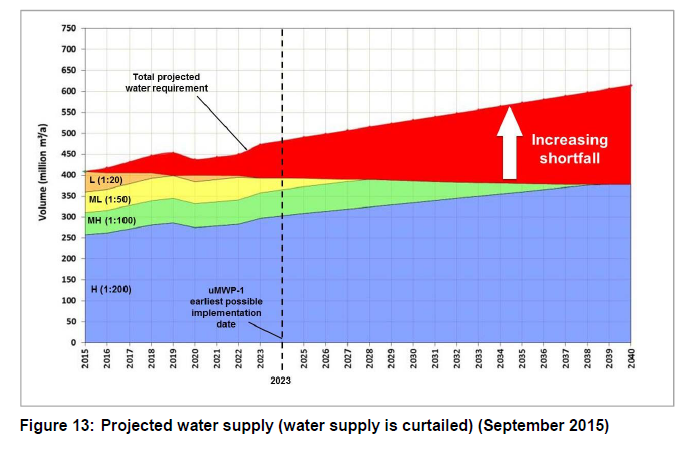
These results confirm that water users in the Mgeni WSS are at significant risk of experiencing either of the following situations prior to the implementation of uMWP-1:
Without curtailments, water supply at the required levels of assurance will continue to drop, and eventually reach an unacceptably high risk of failure Even with curtailments, an increasing shortfall in water supply if water use is curtailed based on available water resources.
Furthermore, it is also clear that the situation will increase in severity if the implementation of uMWP-1 is delayed. This will result in more regular water restrictions and possibly significant negative socio-economic impacts. The implementation of uMWP-1 must therefore be prioritised with focused decision making and adherence to the project programme.
Finally it should be noted that the perception of whether the projected risks are acceptable will most likely vary from institution to institution, as well as from individual to individual. However, the risk should be evaluated against the potential monetary savings associated with not implementing costly interim intervention options (i.e. re-use or desalination) prior to uMWP-1
2. WATER CONSERVATION AND WATER DEMAND MANAGEMENT
Water conservation and water demand management (WC/WDM) is an important intervention for dealing with short- and medium-term water supply challenges. Due to the interconnectedness of the water supply systems in the Strategy area, a failure by any of the Water Service Authorities (WSAs) to implement and maintain appropriate WC/WDM initiatives will have a significant impact on all other users. Even if completely successful, WC/WDM measures will not be sufficient to ensure sufficient future water availability in the area and further significant interventions are required.
The current WC/WDM initiatives of the eThekwini MM, iLembe DM, Ugu DM and Msunduzi LM have resulted in a significant saving of water in the KwaZulu-Natal Coastal Metropolitan area. Considering the challenges and success of WC/WDM initiatives, the following was noted:
The municipalities have a focussed strategy with associated budgets to implement WC/WDM initiatives. To ensure its success, WC/WDM must be viewed as more than simply a series of technical interventions as it depends heavily on social perceptions and behaviours and strong public support.
-
Ageing infrastructure is one of the main causes of leaks.
3. INFRASTRUCTURE PROJECTS
3.1 Mooi Mgeni Transfer Scheme
The Mooi-Mgeni Transfer Scheme (MMTS) was developed to augment water supply to the Mgeni WSS, and comprises the Mearns Weir, the recently commissioned Spring Grove Dam on the upper Mooi River and the associated conveyance infrastructure. Once commissioned in its entirety, MMTS (including Phase 2A and B) will increase the current yield of the Mgeni System by 60 million m3/a (at Inanda Dam). The Trans Caledon Tunnel Authority (TCTA) implemented Phase 2A on behalf of DWS and Spring Grove Dam was completed on 3 March 2014. Furthermore, the 14.9 km Phase 2B pipeline has been completed (apart from 0.1 km railway/R103 crossing), and commissioning is expected early in 2016.
3.2 Raising of Hazelmere Dam
The raising of Hazelmere Dam by 7 m with a piano key weir to increase the gross storage capacity from 23.9 to 43.7 million m³ will augment the water supply to the North Coast area (from the Mdloti to the Thukela River) and sustain irrigation downstream of the dam. Progress to date includes the following activities:
People displaced are being consulted by Land Matters and professional evaluators.
-
Demolition of existing buildings and minor civil works has been completed.
-
14 Valuation reports were approved by the Minister, 20 valuation reports are still outstanding.
-
The resettlement is in process.
-
Construction:
-
Civil Works contractor is appointed; site hand-over was done on 30 June 2015.
-
Commencement date for construction was on 01 July 2015.
-
Construction period is 24 months.
-
An estimated 300 jobs will be created over the construction period.
3.3 North Coast pipeline and Hazelmere Supply Infrastructure
In line with the planned raising of Hazelmere Dam and anticipated increase in available water, Umgeni Water has proceeded with upgrading the water treatment and supply infrastructure linked to the dam. Progress is as follows:
A new raw water pipeline from Hazelmere Dam to the Hazelmere water treatment works (WTW), upgrade of the Hazelmere WTW from 45 to 75 Mℓ/d and a pump station at the WTW. All have recently been completed.
-
The WTW and new infrastructure can only be operated at the increased capacity on a sustained basis once the raising of Hazelmere Dam has been completed.
3.4 Lower Thukela Bulk Water Supply Scheme
The expected growth in the water requirements in the KwaDukuza area will be met from the LTBWSS. The scheme involves the abstraction of water from the lower Thukela River (near the SAPPI mill) and treatment at a regional WTW. Construction started in February 2014, comprising the abstraction works, pump stations, desilting works, WTW and storage reservoirs. The construction of a gravity pipeline from the Mvoti reservoir to Darnall is also underway. It is anticipated that the scheme will be commissioned by mid-2016.
4. FEASIBILITY STUDIES
4.1 uMkhomazi River Transfer Scheme
The first phase of the uMWP-1 comprises a new dam at Smithfield on the uMkhomazi River, water conveyance infrastructure (including a 32 km tunnel), a balancing dam and WTW in the uMlaza valley, as well as a gravity potable water pipeline connecting the uMWP to the Umgeni Water bulk distribution network. Although augmentation of the Mgeni WSS is required from 2017 onwards, the uMWP can only be implemented by 2023. Institutional arrangements to ensure the timely implementation of this scheme are therefore of critical importance.
Feasibility studies currently being finalised by DWS and Umgeni Water provide the project layout and size of infrastructure components, for both the raw water and potable water components of the scheme. The specialist Environmental Impact Assessment (EIA) is underway and the aim is to present submissions to the relevant authorities by November 2016.
4.2 Mvoti River Development
The Mvoti River Feasibility Study involves assessing the development of a large dam on the Mvoti River, either at Isithundu or Welverdient, with a regional WTW and bulk distribution infrastructure. The proposed three-year study has been delayed, but DWS will continue with the study to ensure that the scheme can be implemented when required. If the scheme is found to be feasible, detailed design of the scheme may be undertaken from 2018 to 2020 and construction from 2020 to 2023. First water delivery is currently estimated at April 2024.
4.3 Re-use of treated sewage effluent
In 2009, eThekwini MM initiated a study to assess the viability of reuse as an option to augment water availability in their area of supply. It was proposed that treated effluent from the KwaMashu and Northern wastewater treatment works is reclaimed and treated to potable standard for reticulation. However, public concerns and negative sentiment has since halted the process. It is therefore unlikely that this option will be pursued to address short-term water supply issues in the area.
4.4 Desalination of seawater option
Umgeni Water is investigating the option of desalinating seawater as an alternative water supply source. A feasibility study is currently being finalised to investigate two 150 Mℓ/d plants, located at Lovu on the South Coast and Tongaat on the North Coast, respectively. The size of these plants is based on the capacity of existing and proposed bulk water supply infrastructure in these areas, which can be utilised to convey the potable water from the plants to the various distribution points.
5. SYSTEM OPERATION MANAGEMENT FORUM
Further to the above interventions, a Systems Operations Forum has been established that is focused on improving system management and managing water restrictions in the area in the event of a drought.
More information on drought management is available under https://www.dws.gov.za/Drought/default.aspx.
6. UPDATING RECONCILIATION STRATEGY INTERVENTION OPTIONS
After the latest SSC meeting of Phase 2 (SSC 8), the list of intervention options was updated with more realistic estimated timelines.
For a more detailed status on each of the intervention options described below, see the SSC Status Reports, stored under the Reports & Documents tab.
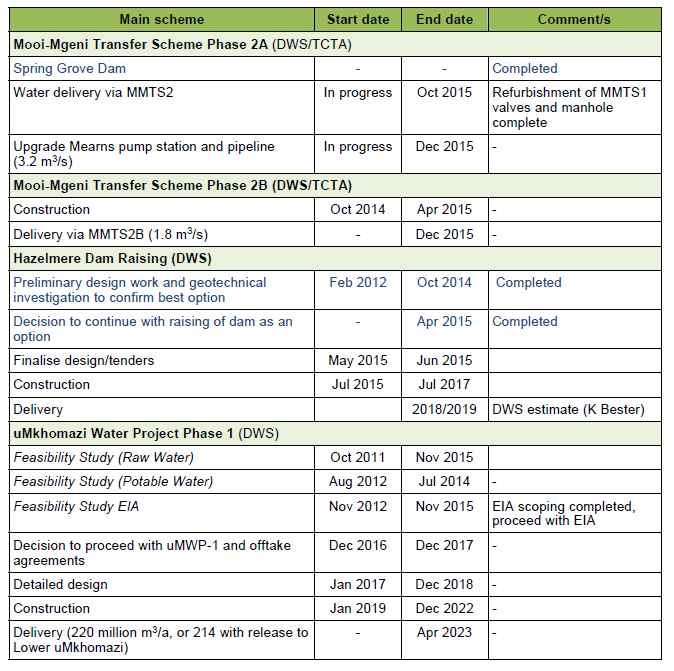
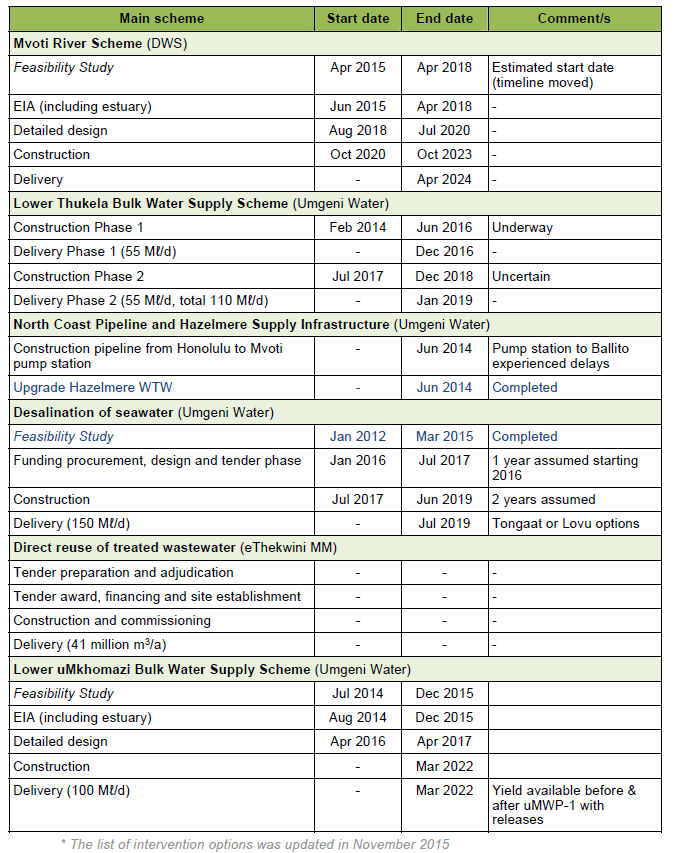
|